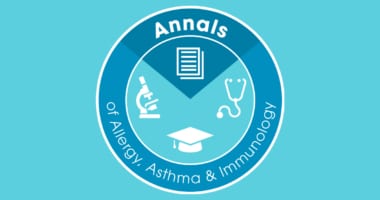 As September winds down, I am hopeful that your teams are winning, that the weather is starting to cool off and that you have had a robust fall allergy season. This month’s Annals of Allergy, Asthma and Immunology issue emphasizes allergen immunotherapy (AIT). Several articles provide new and updated information regarding the basis for effective use of AIT, and I would like to call your attention to two of them, both written by our European colleagues.
As September winds down, I am hopeful that your teams are winning, that the weather is starting to cool off and that you have had a robust fall allergy season. This month’s Annals of Allergy, Asthma and Immunology issue emphasizes allergen immunotherapy (AIT). Several articles provide new and updated information regarding the basis for effective use of AIT, and I would like to call your attention to two of them, both written by our European colleagues.
The first is a review, written by Natasha Gunawardana, MRCP, and Stephen Durham, MD, from London, that reviews the literature and describes the rationale and background for modifications in standard subcutaneous allergen immunotherapy (SCIT). They describe the basis for effectiveness of various adjuvants including new toll-like receptor 4 agonists which may shorten duration of therapy, allergoids, nanoparticles and virus-like particles. They all appear to have efficacy but with varying levels of evidential support. Other agents used in conjunction with SCIT are also described such as omalizumab, different modalities (such as intralymphatic and epicutaneous), administration and B and T peptides. This article provides an excellent overview of where we are and where we may be going with SCIT.
Another article you will want to be sure to read this month is a review of the diverse reported mechanism of effectiveness of allergen-specific immunotherapy written by Anna Głobińska, PhD, and colleagues, from Professor Mübeccel Akdis’, MD, PhD, group in Davos, Switzerland. Their review supports the increasingly accepted notion that the efficacy of AIT is tied to tolerance induction leading the host immune response away from the pro-allergic Th2 (type 2) immune imbalance. The induction of various regulatory cells (both T and B cells), allergen-specific (blocking) antibodies and deceased mast cell/basophil activity are all described. The authors provide direction for the biomarker profile that will be needed to predict responders and determine duration of AIT in a more individualized, precision medicine setting.
Again, we hope these and other articles of a broad and diverse educational nature will be useful to you in updating and expanding your science knowledge for future therapeutic and diagnostic developments. Of course, we have tried to include features that can help your patients tomorrow as well. Please let us know how we are doing in our quest to provide this information for you. Please send me your comments or stop me at our Annual Scientific Meeting in Seattle. I would love to say hi and hear your thoughts about Annals.
Gailen Marshall, Jr., MD, PhD, FACAAI
Editor-in-chief

